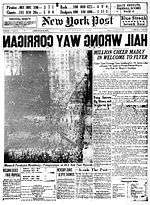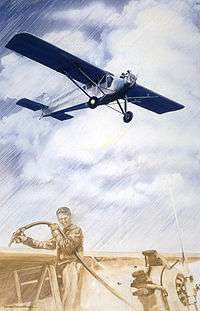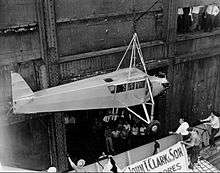Douglas Corrigan
Douglas Corrigan (January 22, 1907 – December 9, 1995) was an American aviator born in Galveston, Texas. He was nicknamed "Wrong Way" in 1938. After a transcontinental flight from Long Beach, California, to New York City, he flew from Floyd Bennett Field in Brooklyn, New York, to Ireland, though his flight plan was filed to return to Long Beach. He claimed his unauthorized flight was due to a navigational error, caused by heavy cloud cover that obscured landmarks and low-light conditions, causing him to misread his compass. However, he was a skilled aircraft mechanic (he was one of the builders of Charles Lindbergh's Spirit of St. Louis) and had made several modifications to his own plane, preparing it for his transatlantic flight. He had been denied permission to make a nonstop flight from New York to Ireland, and his "navigational error" was seen as deliberate. Nevertheless, he never publicly admitted to having flown to Ireland intentionally.
Early life
The son of a construction engineer and a teacher, he was named Clyde Groce Corrigan[1] after his father, but legally adopted the name Douglas as an adult.[2] Corrigan was of Irish descent.[3] The family moved often, until his parents finally divorced and shared custody of their children. Corrigan finally settled with his mother, brother Harry, and sister Evelyn in Los Angeles. Quitting high school, he went to work in construction.
In October 1925, Corrigan saw people paying to be taken for short rides in a Curtiss JN-4 "Jenny" biplane near his home. He paid the $2.50 (equal to $33.79 today) for his own ride. A week later, he began flying lessons, spending non-flying time watching and learning from local aircraft mechanics. After twenty lessons, he made his first solo flight on March 25, 1926.
Aircraft mechanic
.jpg)
Ryan Aeronautical Company operated from the airfield where Corrigan learned to fly, and hired him for their San Diego factory. Corrigan was responsible for assembling the wing and installing the fuel tanks and instrument panel of Charles Lindbergh's Spirit of St. Louis. Corrigan and his colleague Dan Burnett increased the lift of the aircraft by extending the wing 10 feet (3.0 m) longer than any previous Ryan design. Corrigan pulled the chocks from the Spirit of St Louis when Lindbergh took off from San Diego to New York to prepare for his historic flight.
After Lindbergh's success, Corrigan decided to duplicate it and selected Ireland as his objective. He discussed the idea with friends and mentioned flying without permission. When Ryan Aeronautical moved to St. Louis in October 1928, Corrigan stayed in San Diego as a mechanic for the newly formed Airtech School. With more than 50 students flying each day, Corrigan could only get flight time during his lunch break.
During his short flights, Corrigan performed aerobatic stunts. His favourite maneuver was the chandelle, in strings of up to a dozen, spiralling from close to the ground. The company disapproved and prohibited him from performing stunts in the company aircraft. Corrigan simply flew to a field further south where his stunts could not be seen by his employers.
Corrigan moved from job to job as an aircraft mechanic, using his employers' planes to develop his flying skills. He gained his transport pilot's certificate in October 1929, and in 1930, started a passenger service between small East Coast towns, with his friend Steve Reich. The most lucrative part of the business turned out to be barnstorming displays promoting short recreational plane rides. Despite business success, after a few years, Corrigan decided to return to the West Coast. In 1933, he spent $310[4] on a used 1929 Curtiss Robin OX-5 monoplane and flew it home, where he returned to work as an aircraft mechanic and began to modify the Robin for a transatlantic flight.
Transatlantic flier

Having installed an engine built from two old Wright Whirlwind J6-5 engines (affording 165 hp (123 kW) instead of the 90 hp (67 kW) of the original) and extra fuel tanks, Corrigan applied to the Bureau of Air Commerce in 1935, seeking permission to make a nonstop flight from New York to Ireland. The application was rejected; his plane was deemed unsound for a nonstop transatlantic trip, although it was certified to the lower standard for cross-country journeys.
Over the next two years, Corrigan made repeated modifications and reapplications for full certification, but none succeeded. Indeed, by 1937, after extensive modifications in the face of increasing regulation, his aircraft was refused renewal of its licence because it was deemed to be too unstable for safe flight. His autobiography expresses his exasperation with official resistance and he is widely thought to have responded by deciding that year to make an unofficial crossing.
Although he never admitted it, he apparently planned a late arrival at New York so that he could refill his tanks and leave for Ireland after airport officials had gone home from work. Mechanical problems extended his unapproved inbound flight to nine days, which delayed him beyond the Atlantic "safe weather window", and he returned to California. As a result of this trip, he named his plane Sunshine, however, federal officials notified Californian airfield officials that Sunshine was not airworthy and it was grounded for six months.

On 9 July 1938, Corrigan again left California for Floyd Bennett Field, Brooklyn, New York. He had repaired the engine, taking his total spent on the aircraft to about $900 (equal to $15,155 today),[5] gained an experimental license, and obtained permission for a transcontinental flight with conditional consent for a return trip. With the Robin cruising at 85 miles per hour (137 km/h) for maximum fuel efficiency, the outward journey took him 27 hours. Fuel efficiency became critical towards the end of the flight: a gasoline leak developed, filling the cockpit with fumes.
Upon his unannounced arrival at Floyd Bennett Field, in the midst of Howard Hughes's preparations for takeoff on a world tour, Corrigan decided repairing the leak would take too long if he was to meet his schedule. His logged flight plan had him returning to California on July 17. Before take off, Corrigan asked the manager of Floyd Bennett Field, Kenneth P. Behr, which runway to use, and Behr told him to use any runway as long as he didn't take off to the west, in the direction of the administration building where Behr had his office. As recorded in Corrigan's autobiography, Behr wished him "Bon Voyage" prior to take-off, perhaps in a nod to Corrigan's intentions to fly the Atlantic. Upon take off at 5:15 in the morning with 320 US gallons (1,200 L) of gasoline and 16 US gallons (61 L) of oil, Corrigan headed east from the 4,200-foot (1,300 m) runway of Floyd Bennett Field and kept going. (Behr later swore publicly he had no foreknowledge of Corrigan's intentions.)
Corrigan claimed to have noticed his "error" after flying for about 26 hours. This is not entirely consistent with his claim that after 10 hours, he felt his feet go cold; the cockpit floor was awash with gasoline leaking from the unrepaired tank. He used a screwdriver to punch a hole through the cockpit floor so that the fuel would drain away on the side opposite the hot exhaust pipe, reducing the risk of a midair explosion. Had he been truly unaware he was over ocean, it seems likely he would have descended at this point; instead, he claimed to have increased the engine speed by almost 20% in the hope of decreasing his flight time.
He landed at Baldonnel Aerodrome, County Dublin, on July 18, after a 28-hour, 13-minute flight. His provisions had been just two chocolate bars, two boxes of fig bars, and 25 US gal (94.64 L) of water.
Corrigan's plane had fuel tanks mounted on the front, allowing him to see only out of the sides. He had no radio and his compass was 20 years old. The journalist H. R. Knickerbocker, who met Corrigan in Ireland after his arrival, wrote in 1941:

You may say that Corrigan's flight could not be compared to Lindbergh's in its sensational appeal as the first solo flight across the ocean. Yes, but in another way the obscure little Irishman's flight was the more audacious of the two. Lindbergh had a plane specially constructed, the finest money could buy. He had lavish financial backing, friends to help him at every turn. Corrigan had nothing but his own ambition, courage, and ability. His plane, a nine-year-old Curtiss Robin, was the most wretched-looking jalopy.As I looked over it at the Dublin airdrome I really marveled that anyone should have been rash enough even to go in the air with it, much less try to fly the Atlantic. He built it, or rebuilt it, practically as a boy would build a scooter out of a soapbox and a pair of old roller skates. It looked it. The nose of the engine hood was a mass of patches soldered by Corrigan himself into a crazy-quilt design. The door behind which Corrigan crouched for twentyeight hours was fastened together with a piece of baling wire. The reserve gasoline tanks put together by Corrigan, left him so little room that he had to sit hunched forward with his knees cramped, and not enough window space to see the ground when landing.[6]
Aviation officials took 600 words to list the regulations broken by his flight in a telegram (a medium that encourages brevity by charging at a rate per word). Despite the extent of Corrigan's illegality, he received only a mild punishment; his pilot's certificate was suspended for 14 days. He and his plane returned to New York on the steamship Manhattan and arrived on August 4, the last day of his suspension. His return was marked with great celebration. More people attended his Broadway ticker-tape parade than had honored Lindbergh after his triumph. He was also given a ticker tape parade in Chicago.
He appeared as a contestant on the July 16, 1957 episode of To Tell the Truth.
Later life
To Corrigan's great disappointment, Lindbergh, his hero and the reason he had made the flight, never acknowledged the accomplishment.[6] Corrigan wrote his autobiography, That's My Story, within months of the flight; it was published for the Christmas market on 15 December 1938. He also endorsed 'wrong-way' products including a watch that ran backwards. The following year, he starred as himself in RKO Radio Pictures' The Flying Irishman (1939), a movie biography. The $75,000 he earned was the equivalent of 30 years income at his airfield jobs.
According to a letter written to a fan in 1940,[7] Corrigan claimed to have "no hobbies except working on airplanes or machinery". When the United States entered World War II, he tested bombers and flew in the Ferry Command, a division of the Air Transport Command. In 1946, he gained less than 2% of the vote running for the U.S. Senate as a member of the Prohibition Party, running against Republican William F. Knowland. He then worked as a commercial pilot for a small California airline.
Corrigan retired from aviation in 1950 and bought an 18-acre (7.3 ha) orange grove in Santa Ana, California. He lived there with his wife and three sons until his death on December 9, 1995. He knew nothing about raising oranges, and said he learned by copying his neighbors. His wife died in 1966, and Corrigan sold most of his grove for development, keeping only the ranch-style house. One of the streets in the 93-house estate is named after him.[8] He became reclusive after one of his sons died in a private plane crash on Santa Catalina Island, California in 1972. In 1988, however, he joined in the golden anniversary celebration of his famous "wrong way" flight, allowing enthusiasts to retrieve the Robin from its hangar. The plane was reassembled and the engine was run successfully.[9] Corrigan was so excited that the organizers placed guards at the plane's wings while he was at the show and considered tethering the tail to a police car to prevent him from taking off in it.[4] Later, Corrigan became elusive about the plane's location. It was rumored he had dismantled and stored it in several locations to prevent its theft.[10]
An anthology of aircraft related mysteries published in 1995 claimed that Corrigan was elected an Honorary Member of the 'Liars Club of America' at the age of 84, and that the 'honor,' (as had so many other suggestions over the years since his transatlantic flight) had been politely but firmly refused. Up to his death, Corrigan still maintained that he had flown transatlantic by accident.
In popular culture
Corrigan's "error" caught the imagination of the depressed American public and inspired many jokes. The nickname "'Wrong Way' Corrigan" passed into common use (sometimes confused with the memory of 1929's "Wrong Way" Riegels football incident)[11][12] and is still mentioned (or used as satire) when someone has the reputation for taking the wrong direction. For example: Corrigan was directly referenced in the 1938 Three Stooges short Flat Foot Stooges. Curly states, "Hey, we're doing a Corrigan!" after realizing they are heading in the wrong direction to get to the fire they need to extinguish. A character named "Wrong Way Feldman" was portrayed by Hans Conreid in two episodes of Gilligan's Island in the 1960s. Also, in the short 'Birds on a Wire', part of the last episode (1998) of Animaniacs, Pesto the Goodfeather pigeon expresses outrage by exclaiming "Are you saying that I don't know my directions? That I'm some sort of 'Wrong Way' Corrigan?" when he is pointed out the fact that he is confusing north with west.
Legacy
Among aviation historians, Corrigan is remembered as one of the brave few who made early transoceanic flights. On his death in 1995, he was buried at Fairhaven Memorial Park in Santa Ana.[13] His memorial is a small horizontal plaque bearing a facsimile of his signature.[13]
See also
References
- ↑ "The Flying Irishman (1939)". Internet Movie Database. Retrieved 22 November 2010.
- ↑ Fadiman 1985.
- ↑ "Texas Trails: "Wrong Way" Corrigan". Countryworldnews.com. 2012-04-17. Retrieved 2014-04-16.
- 1 2 Thomas, Robert McG Jr. (December 14, 1995). "Douglas Corrigan, 88, Dies: Wrong-Way Trip Was the Right Way to Celebrity as an Aviator". New York Times. Retrieved November 22, 2010.
- ↑ "Corrigan Off On Mystery Hop". Allentown Morning Call. July 18, 1938. p. 1.
- 1 2 Knickerbocker, H.R. (1941). Is Tomorrow Hitler's? 200 Questions On the Battle of Mankind. Reynal & Hitchcock. pp. 353–355.
- ↑ Quinn's Auction Galleries Catalogue, Feb 2004
- ↑ Marsh
- ↑ Fyn
- ↑ San Diego Air and Space Museum Arch Waller
- ↑ Richard Goldstein. "COLLEGE FOOTBALL; Revisiting Wrong Way Riegels - New York Times". Nytimes.com. Retrieved 2014-04-16.
- ↑ Guts in the Clutch: 77 Legendary Triumphs, Heartbreaks, and Wild Finishes in ... - Richard J. Noyes - Google Books. Books.google.com. 2009-04-30. Retrieved 2014-04-16.
- 1 2 Douglas "Wrong Way" Corrigan at Find a Grave
- Bibliography
This article is derived from the sources listed here. The essential sources are Corrigan (1938) and Fasolino (2001).
- 'Douglas "Wrong Way" Corrigan', Find A Grave Cemetery Records, (2000). Retrieved December 22, 2005.
- Important Autographs with Fine Antiques & Decorative Arts Auction Catalogue, (Falls Church, VA: Quinn's Auction Galleries, February 16, 2004).
- Corrigan, Douglas. That's My Story (New York: E.P. Dutton, 1938)
- Fadiman, Clifton. The Little, Brown Book of Anecdotes, (New York: Little, Brown, 1985) ISBN 978-0-316-27301-5
- Fasolino, Chris. 'The Adventures of Wrong-Way Corrigan', The History Net (2001). Retrieved August 24, 2005.
- Fraser, Chelsea Curtis. Famous American Flyers, (New York: Thomas Y. Crowell, 1941)
- Fyn, Chip. 'The Story of Wrong Way Corrigan', Fiddler's Green (April 2003). Retrieved August 24, 2005.
- Knickerbocker, H. R. Is Tomorrow Hitler’s?, (New York: Reynal & Hitchcock, 1941).
- Marsh, Diann. 'Wrong Way Corrigan', Santa Ana History. Retrieved August 24, 2005.
- Onkst, David H. 'Douglas "Wrong Way" Corrigan', US Centennial of Flight Commission. Retrieved August 24, 2005.
- Sears, Stan. 'Corrigan’s Way: Right or Wrong, He Made His Mark on History', Airport Journals (March 2005)]. Retrieved August 24, 2005.
- Wallechinsky, David & Wallace, Irving 'Where Are They Now? Flying Irishman Douglas Corrigan'. Trivia-Library.com (1981). Retrieved November 22, 2005.
External links
- Douglas Corrigan at Find a Grave
- Photographs of Wrong Way Corrigan's plane at Baldonnel Aerodrome, Dublin Ireland